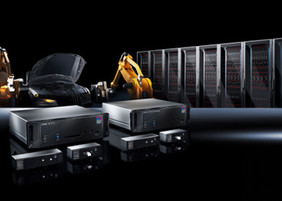Background
Today’s control cabinets typically accommodate sensitive electronic components to host them in a defined environment and to protect them against external influences. No matter if the application is IT or industry related, if these electronic components fail—besides the function loss of the component itself—this can easily result in data loss which typically is even more expensive. To avoid possible damages, the majority of the users count on automatic monitoring systems for early detection of critical environmental conditions.
With their Computer Multi Control (CMC III) Rittal offers a modular monitoring system for IT, building and industry applications. Using different sensors, the environmental conditions within the control cabinet are constantly evaluated. If a threshold value is exceeded (e.g. temperature) the system automatically notifies the technician or IT administrator via email or SMS. Depending on the measured value the CMC III is additionally able to signal on physical outputs. Thus, ventilation or signal lights can automatically be switched on for example. The system is composed of different components: the core component is the central CMC III Processing Unit. Up to 32 sensors can be connected to this unit. These sensors are connected to the Processing Unit via CAN-Bus in a daisy-chain.
Due to the modular concept this system can be adapted to multiple individual use cases and applications—starting from a single cabinet with a machine controller up to entire rows of cabinets in a data center.
Challenge
The central Processing Unit comes with different interfaces, that can be used for interacting between users or management systems and the CMC III system. A USB interface enables the initial configuration of the system—a push button can be used to acknowledge alarms. The Ethernet interface is used to integrate the system into data network. Via Ethernet customers can not only access the integrated web front end, but via SNMP the system can communicate with network management systems.However, the SNMP protocol is typically used in IT environments only but it is not very common in SCADA/HMI systems. The CMC III system must be enhanced with a standard communication protocol for industrial applications. The new protocol must be implemented and run within the embedded Linux operating system of the CMC III Processing Unit.
Solution
When looking for a widely used communication standard in industry, Rittal decided to use OPC UA, to provide the measured data of the monitoring system also for building and automation systems. With the two supported standard protocols SNMP and OPC-UA the values can either be provided to IT for use in their data center infrastructure management, but also to industrial automation and their SCADA/HMI or to building control system. Additionally the UA standard provides a simple handling of the modularity of the CMC III. Legacy systems using other communication standards must be reconfigured when the CMC III changes its content, but OPC UA provides a sequential method for obtaining the device configuration. The preferred solution is an automatic system reconfiguration accompanied by a client-side detection of changes.
OPC Unified Architecture
- platform independent
- scalable, robust, secure
- flexible object oriented modeling
- IEC 62541 standardized
OPC UA Background
The “classic” OPC interfaces Data Access, Alarms&Events and Historical Data Access (DA, A&E, HDA) are based in the Microsoft technology COM/DCOM (Component Object Model) and therefore can only be run on Microsoft operating systems. The new OPC UA specification defines a Service Oriented Architecture (SOA), which is platform independent and which functionally includes and unifies all legacy versions of OPC. The new communication stacks in ANSI C/C++, Java and .NET implement the low level protocol features. Additionally message signing and encryption as well as authentication and authorization via x509 certificates are already included. The most significant innovation of OPC UA is the extensive support for information modeling. Information entities (Nodes) and relationships between them (References) follow an object oriented design paradigm. Not only the data itself but also the related meta data including its semantics can be generically described and transported over the network.
Used Products of Unified Automation
“The UA SDK from Unified Automation could easily be integrated into our build environment and OPC UA could seamlessly be cross compiled for our target system” says Fabian Schaefer, Product Manager CMC III at Rittal.
Rittal used the ANSI C based OPC UA Server SDK for the development of their UA Server on an embedded system. The SDK comes with the full, platform independent source code, Linux platform layer and includes a build system. Thanks to the platform independence the integration of the OPC UA server into the existing build structure could be done without any problems and within shortest time frame. The modular, layered concept of the SDK enables stepwise support even when being new in the OPC UA technology. E.g. initially only the basic functions like Data Access, Subscription and data structures were implemented in the software of the CMC III system. The customer quickly writes running software and adds OPC-UA support to his product, even though not all possibilities and features of the UA standard were used. In a later version the software can be enhanced with additional features, with just a little effort – like adding support for Historical Data, Authentication, Alarms and Events, etc.
About Rittal
 Rittal with its headquarter in Herborn, Germany, is a world leading system provider for cabinets, current distribution, air conditioners, IT infrastructure and software & service. Rittal’s system solutions are used in all areas of industry, in machinery and plant manufacture as well as in the ITK branch.
Rittal with its headquarter in Herborn, Germany, is a world leading system provider for cabinets, current distribution, air conditioners, IT infrastructure and software & service. Rittal’s system solutions are used in all areas of industry, in machinery and plant manufacture as well as in the ITK branch.

